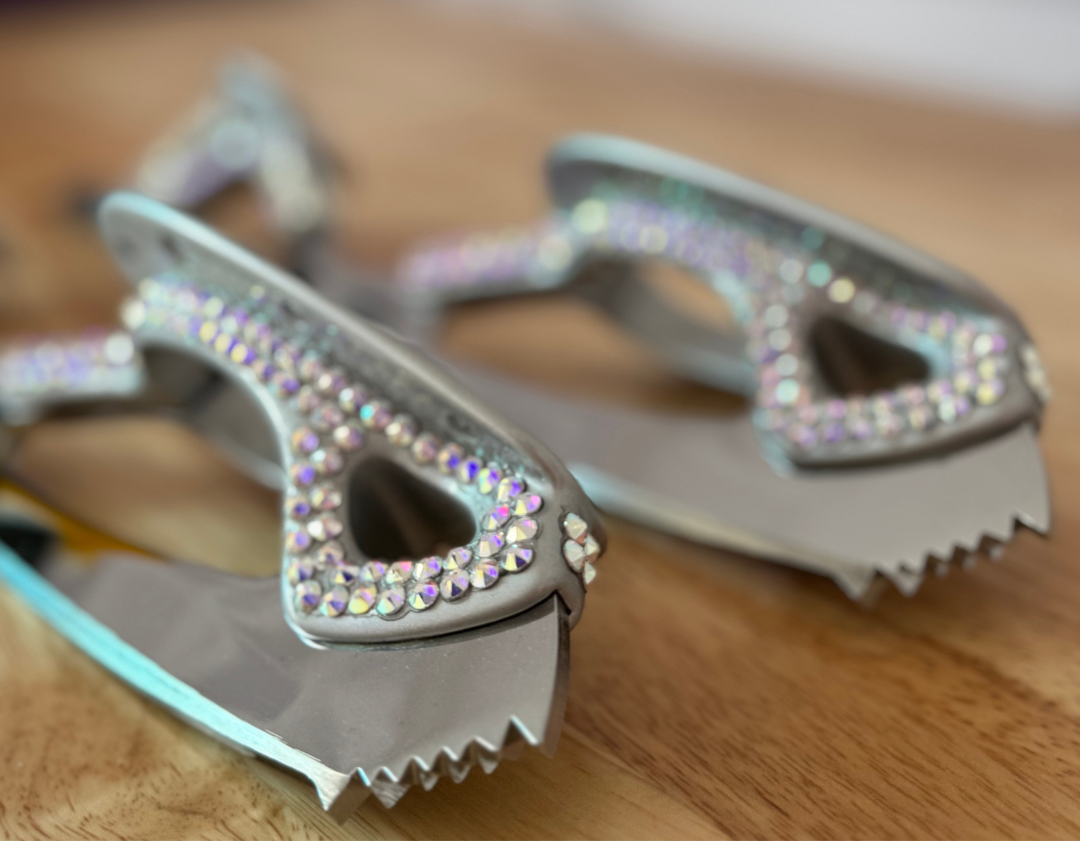Mastering Your Blade: A Fresh Guide to Choosing Figure Skating Blades
Published on June 1, 2025 by AST
For freestyle figure skaters, selecting the right blade is a game-changer. It’s not just about aesthetics—the design of your blade affects your spins, jumps, and overall performance on the ice. In this guide, we break down the key components of figure skating blades, from the rocker and toe pick to various blade styles and profiles, so you can choose the best equipment for your skating journey.
Understanding the Rocker: The Curve That Defines Your Ride
The term rocker refers to the curvature along the bottom of your blade. This curvature determines how the blade “rocks” on the ice, influencing everything from edge control to your jumping technique.
7-Foot vs. 8-Foot Rockers
A 7-foot rocker features a more pronounced curve:
- Pros: Offers a forgiving surface for spins and three-turns, allowing for smoother transitions and deeper edge work.
- Cons: The increased curvature means less contact area for landing, which can reduce stability on jumps.
An 8-foot rocker is flatter:
- Pros: Provides greater stability and better edge control, essential for safe and consistent jump landings.
- Cons: Its flatter profile can make it harder to find the ideal spin entry point, requiring more precision.
Most skaters begin with a 7-foot rocker to master spin techniques, transitioning to an 8-foot rocker as they develop the precision needed for advanced jumps.
The Toe Pick: Balancing Grip and Agility
The toe pick plays a crucial role during takeoffs, jump landings, and even in initiating spins. It can be seen as the bridge between power and precision on the ice.
Straight Cut vs. Cross Cut
Straight cut picks are engineered to dig deeply into the ice:
- They’re excellent for skaters who have honed their jumping technique and need extra leverage for high takeoffs.
- They can, however, increase the risk of slippage if your form isn’t consistent.
In contrast, cross cut picks provide a more secure grip without compromising on control, making them a popular choice for beginners and intermediates. For those seeking extra stability, some blades offer an enhanced K-pick variant with additional side pick features.
Exploring Blade Styles: Tailoring Equipment to Your Performance
Blade style influences not only the aesthetics of your skate but also your performance. Here are some common designs:
- Parallel Blades: The standard option, known for their ease of sharpening and consistency.
- Parabolic Blades: Featuring a thinner center, these blades help to concentrate your weight for greater control.
- Tapered Blades: With a thinner tail section, they reduce drag to increase speed.
- Side-Honed Blades: Material is removed from the sides, creating a lighter blade with sharper edge angles—ideal for skaters who want enhanced bite without sacrificing stability.
- Revolution Blades: Designed with a composite chassis for a bit of flex, they cushion the impact forces during landing and high-intensity jumps.
Nailing the Blade Profile: Finding Your Sweet Spot
The blade profile concerns where the spin rocker—the section of the blade that comes into play during spins—is positioned. The “sweet spot” should ideally be located just ahead of the ball of your foot, where your skate naturally flexes. This positioning ensures optimal balance during spins while maintaining the necessary curvature for edge control.
Although the spin rocker’s curvature may mirror the main rocker’s design, its accurate placement is critical for seamless transitions between spins and jumps.
Blade Transition Recommendations: Evolving With Your Skills
Beginners often start with models designed to assist with learning spins and jump takeoffs. For example, entry-level blades such as those with a 7-foot rocker and cross cut toe picks provide extra security as you work on your technique.
Once your skills improve, you might consider a transition to more advanced models. Upgrading to a blade with an 8-foot rocker can offer enhanced stability on jump landings, while blades retaining a 7-foot rocker but featuring unique toe pick designs can cater to skaters who specialize in complex jump dynamics. The key is to maintain a familiar blade profile so the evolution in your equipment feels more like a natural progression than a complete overhaul.
Investing in Quality: Understanding the High-End Difference
Higher-end blades justify their price in several ways:
- Advanced features such as side honing and tapering reduce friction and improve responsiveness.
- The chassis is constructed from lightweight or tougher materials like carbon fiber, aluminum, or titanium.
- Premium Sheffield Steel is used, leading to fewer sharpening sessions and a longer-lasting blade that withstands the rigors of high-impact performance.
These benefits can mean significant savings over time—both in terms of performance and reduced maintenance costs—making them a smart investment for frequent skaters.
Meet the Masters: Key Blade Manufacturers
When it comes to quality, a few manufacturers have stood the test of time:
- John Wilson and MK (Mitchell & King): Renowned for their premium Sheffield Steel and long heritage in blade production.
- Ultima (by Jackson): Offering both high-end and more accessible options to suit various skill levels.
- Riedell and Jerry’s: Trusted names in the North American market.
- Paramount: A well-regarded manufacturer in the United States known for consistent performance.
For instance, John Wilson has a fascinating history—originally known for its knife production in the 1600s, it eventually pivoted to creating world-class figure skating blades.
Conclusion: Choose Wisely, Skate Confidently
Choosing the right figure skating blade goes beyond style—it’s about aligning your equipment with your unique performance needs. Understanding rocker curvature, toe pick design, blade style, and profile positioning provides the insight you need to make informed decisions. Whether you’re just starting out or ready to make a significant upgrade, choose a blade that not only complements your skating style but also helps you push your boundaries safely. Skate confident, and enjoy the journey to mastering your blade!

